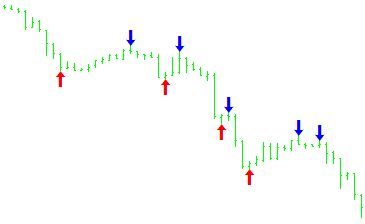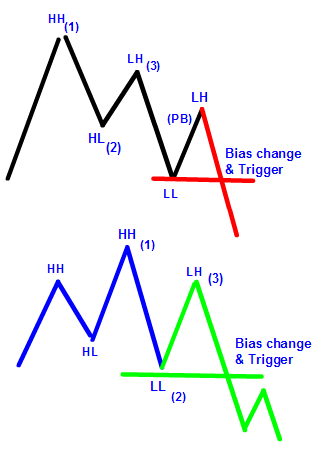Essential Elements of a Successful Trader
by FxLegend
Courage Under Stressful Conditions When the Outcome is Uncertain
All the foreign exchange trading knowledge in the world is not going to help, unless you have the nerve to buy and sell currencies and put your money at risk. As with the lottery “You gotta be in it to win it”. Trust me when I say that the simple task of hitting the buy or sell key is extremely difficult to do when your own real money is put at risk.
You will feel anxiety, even fear. Here lies the moment of truth. Do you have the courage to be afraid and act anyway? When a fireman runs into a burning building I assume he is afraid but he does it anyway and achieves the desired result. Unless you can overcome or accept your fear and do it anyway, you will not be a successful trader.
However, once you learn to control your fear, it gets easier and easier and in time there is no fear. The opposite reaction can become an issue – you’re overconfident and not focused enough on the risk you're taking.
Both the inability to initiate a trade, or close a losing trade can create serious psychological issues for a trader going forward. By calling attention to these potential stumbling blocks beforehand, you can properly prepare prior to your first real trade and develop good trading habits from day one.
Start by analyzing yourself. Are you the type of person that can control their emotions and flawlessly execute trades, oftentimes under extremely stressful conditions? Are you the type of person who’s overconfident and prone to take more risk than they should? Before your first real trade you need to look inside yourself and get the answers. We can correct any deficiencies before they result in paralysis (not pulling the trigger) or a huge loss (overconfidence). A huge loss can prematurely end your trading career, or prolong your success until you can raise additional capital.
The difficulty doesn’t end with “pulling the trigger”. In fact what comes next is equally or perhaps more difficult. Once you are in the trade the next hurdle is staying in the trade. When trading foreign exchange you exit the trade as soon as possible after entry when it is not working. Most people who have been successful in non-trading ventures find this concept difficult to implement.
For example, real estate tycoons make their fortune riding out the bad times and selling during the boom periods. The problem with trying to adapt a 'hold on until it comes back' strategy in foreign exchange is that most of the time the currencies are in long-term persistent, directional trends and your equity will be wiped out before the currency comes back.
The other side of the coin is staying in a trade that is working. The most common pitfall is closing out a winning position without a valid reason. Once again, fear is the culprit. Your subconscious demons will be scaring you non-stop with questions like “what if news comes out and you wind up with a loss”. The reality is if news comes out in a currency that is going up, the news has a higher probability of being positive than negative (more on why that is so in a later article).
So your fear is just a baseless annoyance. Don’t try and fight the fear. Accept it. Have a laugh about it and then move on to the task at hand, which is determining an exit strategy based on actual price movement. As Garth says in Waynesworld “Live in the now man”. Worrying about what could be is irrational. Studying your chart and determining an objective exit point is reality based and rational.
Another common pitfall is closing a winning position because you are bored with it; its not moving. In Football, after a star running back breaks free for a 50-yard gain, he comes out of the game temporarily for a breather. When he reenters the game he is a serious threat to gain more yards – this is indisputable. So when your position takes a breather after a winning move, the next likely event is further gains – so why close it?
If you can be courageous under fire and strategically patient, foreign exchange trading may be for you. If you’re a natural gunslinger and reckless you will need to tone your act down a notch or two and we can help you make the necessary adjustments. If putting your money at risk makes you a nervous wreck its because you lack the knowledge base to be confident in your decision making.
Patience to Gain Knowledge through Study and Focus
Many new traders believe all you need to profitably trade foreign currencies are charts, technical indicators and a small bankroll. Most of them blow up (lose all their money) within a few weeks or months; some are initially successful and it takes as long as a year before they blow up. A tiny minority with good money management skills, patience, and a market niche go on to be successful traders. Armed with charts, technical indicators, and a small bankroll, the chance of succeeding is probably 500 to 1.
To increase your chances of success to near certainty requires knowledge; acquiring knowledge takes hard work, study, dedication and focus. Compile your knowledge base without taking any shortcuts, thereby assuring a solid foundation to build upon.
------------------------------------------------------------------------------------------------------------
Choosing a Forex Broker
As you may already know, foreign exchange (Forex/FX) is an unregulated market that is not traded on an exchange, which means that prices you see and get from one broker could vary from those of another broker. There are mainly two types of brokers. One type is an ECN (Electronic Communications Network) and another a Market-Maker.
Market-makers "make" or set the prices on their systems based on what they think is best for themselves as the counter-party. This is because every time you sell, they must buy, and when you buy, they must sell to you. This is why they can give you a fixed spread since they are setting both the bid and the ask price. Many of them will then try to "hedge" or "cover" your order by passing it on to someone else; however, some may decide to hold your order, and thus trade against you. This can result in a conflict of interest between the retail trader (you) and the market-maker.
ECNs, on the other hand, pass on prices from several banks and market-makers, as well as from the other traders in the ECN, and display the best bid/ask prices based on these input. This is why sometimes you can get no spread on ECNs, especially in very liquid currency pairs. How do ECNs make money then? They do so by charging you a fixed commission for each transaction.
--------------------------------------------------------------------------------------------
The Advantages of Trading Alone
by forexlegend
People sometimes experiment with the idea to trade with other people. It might work, but for me, it did not. I trade alone. The advantages of trading alone are:
- You are free to make your own decisions without having to find a way to explain the rationale of your decisions to anybody else. Your time and effort can be focussed on what the market is doing and how you react to it, instead of worrying about the psychological and emotional dynamics of a trading group.
- You are free to experiment, based on the knowledge you gain from your experiences and your self-education, without having to asking others to allocate a certain portion of the trading funds to let you conduct your experiments.
- No one can blame you for their failures. No time is wasted on justifying your actions or feeling guilty about the impact of your trading blunders on someone else's financial situation.
- You alone are responsible and accountable for your own success or failure. You cannot shift the blame to anybody else. It could be disappointing to some knowing that they cannot blame anyone else if they fail. For others, it is very empowering to know that they, and they alone, are in charge of their own destiny.
Personally, I believe that a person should trade alone first before he or she decides to trade with other people. This allows the individual to develop his own philosophy and his own understanding about himself and the market. I understand, however, that not everybody can trade alone because it requires a set of beliefs and values to be part of the trader's character. Not all people are created with the same set of characteristics. Not everyone can operate under the solitude of the journey. For example, there are people who need social contact more than others. Individuals who are social by nature and those who solve problems by talking to other people, may have difficulty undertaking a solitary endeavour.
Furthermore, there are people who do not have faith in their abilities and in their capacity to learn to trade successfully. I know of individuals who need constant reassurance before they take any step towards their goals. In similar circumstances, trading in a group may be the only option available for some people to give them the push they need: otherwise, they may never start.
------------------------------------------------------------------------------------------------------------
Price Action and Candlesticks
by FxLegend
| Swing Highs and Lows The first thing that we need to recognise is what is a Swing High and Swing Low. This is probably the easiest part of price action and bar counting although the whole process gets easier with practice.
Market Phases There are only three ways the market can go;
In short
What do I mean by timing? It may be that you are looking for a shorting opportunity as the overall trend is down but price on your entry time frame is still going up (making HH's & HL's). There is, at this stage, no point in trying to short a rising market until price action start to point down (making LH's & LL's. More on this shortly).
Trending Price Action After a bias change has been seen and confirmed, one of the phases that the market can then take is to start trending either up or down depending on the bias change previously. In the chart below we can see what price ideally looks like when price is trending up and trending down. Each phase shows price making HH's & HL's on its way up and LH's & LL's on its way down.   Ranging Price action Now this is where the chart can become interesting. By using the price action counting of the swing highs and lows we can know at a very early stage IFprice is going to start to develop range bound activity.
Range rule definitions
At the point of the chart, in real time, price needs to either start moving higher past the last swing high (red Arrow) making a new high OR move lower past the last swing low (blue arrow) making a new low. Until either of those things happens price will most likely remain range bound. In this example that is what happened. Range considerations Some considerations for identifying ranges at an early stage in real time are;
  Acronyms used
| ||||||||||



